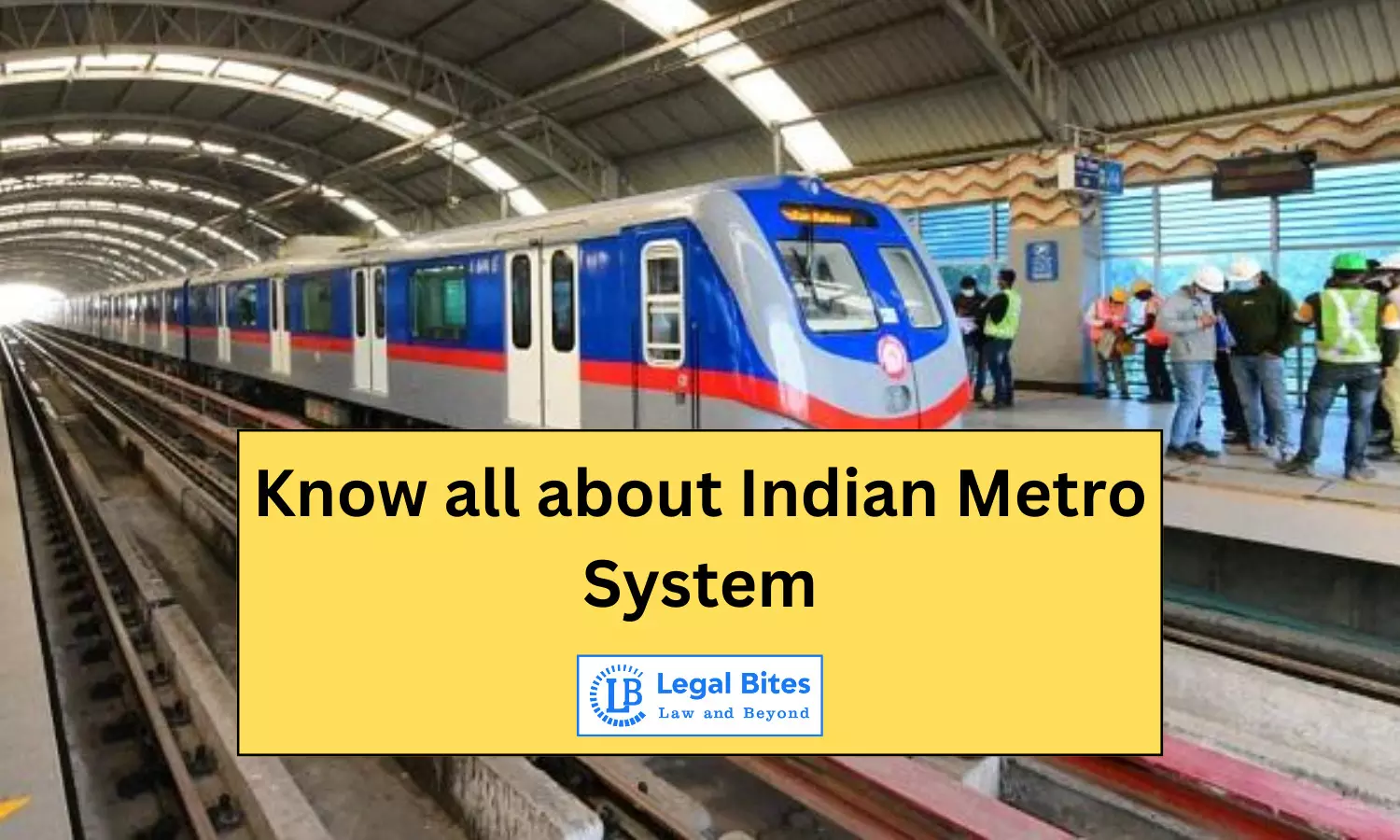Know all about Indian Metro System
The article ‘Know all about Indian Metro System’ by Snehil Sharma delves into the intricacies of the metro rail system in India while understanding its importance and benefits.

The article 'Know all about Indian Metro System' by Snehil Sharma delves into the intricacies of the metro rail system in India while understanding its importance and benefits. It will also study the impact of metro rail on Delhi and Kolkata, being metropolitan cities with humongous populations.
Introduction: Metro Rail in India
India started the metro rail system rather very late in comparison to the first recommendation made for it back in the year 1919 by W.E. Crum in the Imperial Legislative Council situated at Shimla. This recommendation discussed the need to establish a metro rail system in Kolkata. This recommendation materialized much later in the year 1984 while the MTP (Metropolitan Transport Project) was considering alternate measures for reducing the traffic problems in Kolkata. Post-1984 in Kolkata, the next metro rail system was set up in India's capital Delhi in the year 2002. This was followed by Bangalore in 2011, and Gurgaon in 2013. The growth and development of these projects for metros were very slow.
There has been a steady growth in the importance of metro rail systems which has often received questions regarding reasons and explanations for a $2000 income per capita country requiring metro transit. Metro rail systems for this reason are also often stapled to be 'unnecessary' as they shift the focus from the requirement of fixing walkability issues and the road improvement projects.
However, the metro rail system is not a novel concept and has remained in the picture for a long time, globally. They are also referred to as 'urban mass rapid transit' systems that assist in solving transportation and traffic issues. Many countries adopted this even when their income was lesser than India's in today's date.
Brief Global History of Metro systems
Let us begin this discussion by understanding the reason behind this system called the 'metro' system. The reason behind this is that this transportation system becomes very useful in places with humongous amounts of populations, which are found in metro cities. This system became important to the extent that back in the year 2017, almost 56 countries and their 178 cities had already adopted it. The distance that is maintained between metro stations is often kept at 1.5 km to increase efficiency and decrease travel time for closer places. Most countries have also adopted the 'underground' metro system in order to assist in the smooth functioning of the metro system. About 65% of all the metro stations in the world are underground metro stations.
Metro rail projects have always been very expensive and this has also been the reason behind their slow and steady success all over the countries. During First World War, the construction work of the metro was halted due to the damage suffered in different areas. During World War-II as well, there was a similar scenario where places such as Berlin underwent heavy losses to the metro rail system due to the bombings. Even Paris had to stop the metro expansions that it had planned for the year when World War - II started gaining traction.
In China too, the metro establishment and expansions in Beijing were halted for about 11 years from the 1950s to 1961. In New York, the issue has been rather different where an increase in crimes and vandalism caused a major need for maintenance which has henceforth been pending since the 1970s.
Impact on Urbanisation
Metro rail systems have highly impacted urbanization and the same can be understood as explained below:
• Increase in Population Density near the metro lines
The reduction in commuting costs makes metro rails more efficient. It has made travel more convenient and thereby improved accessibility. Buyers want to move to places closer to the metro stations to make use of the metro rail facility.
• Better 'standards of living'
This has been achieved by establishing the metro rail system as a 'catalyst' for the promotion and adherence to sustainable development. Metros have increased the standard of living as the same is a new, modern adaptation of a futuristic travel modality based on making use of new technological advancements.
• Establishment of 'sub-urban clusters'
This has been achieved by a massive increase in real estate prices for properties along the metro rail and in its close proximity. The prices of properties are inversely related to the distance to the metro station. The ease of facility provided by the metro has enhanced reach and connectivity.
Key Benefits of Using Metro
Some of the benefits of using the metro are mentioned below:
- Eco-friendly way of travel leads to lesser carbon emissions otherwise generated by cars and other vehicles. Greenhous gases are not emitted.
- The time taken for travelling long distances can be decreased considerably and the time wastage in traffic jams can also be effectively avoided.
- Metro rails consist of very large capacities which facilitate them in being high-capacity passenger carriers. They also occupy less ground space in comparison to other travel systems.
- They are very cost-effective as the money charged is lesser when compared with other alternate options of traveling by road.
- They are convenient as no driving or understanding of routes by road is required. People only need to know the closest metro station to their destination.
Factors that make the metro imperative
The following factors have made the metro very important:
- There is less space for constructing other transportation modes as the roads are narrow and there are buildings and complexes which take up maximum space.
- Traffic congestion is witnessed due to large number of vehicles in small areas.
- In peak hours, traffic increases considerably which leads to PHPDT (Peak Hour Peak Direction Traffic).
- Greater demand for metro due to cost effectiveness benefit to the passengers.
- The number of passengers remains very high on movement routes.
Metro in India: Spotlight Kolkata
India's first rapid transit system was the Kolkata Metro. In the 1920s, plans for it were first made. The government came up with the concept of constructing an underground railway for Kolkata. But the metro building didn't begin until the 1970s. Between Bhawanipore (now known as Netaji Bhawan) and Esplanade, the north-south corridor's first elevated section opened in 1984. Later, it was expanded from Dum Dum to Tollygunge and then on to Noapara in the north and New Garia (called Kavi Subhash) in the south.
One of the world's most populous cities, Kolkata is one of the largest with 1750 sq km and about 15 million people. The economic, commercial, and financial centre of eastern and northeastern India is Kolkata. Compared to other comparable metro cities in India, where roads make up more than 20% of the total area, the city has only 6% of them. The metropolis is bursting at the seams with an anticipated 1.6 million vehicles and 23.50 million transit journeys daily in 2011. There is extremely little room to expand the city's road network since, in 2025, there will be 3 million more vehicles on the road and 32 million more daily transit trips.
Metro in India: Spotlight Delhi
Without any doubt, India's most effective transit system is the Delhi Metro, with a 351-kilometer operational network sub-urban rail network linking communities at the region's many ends (NCR). With an annual traffic volume of, as of 2017, Delhi Metro was the seventh-busiest Metro in the world with a 1.79 billion passenger volume. The Delhi metro network is anticipated to grow to 470 kilometers in the following seven to five years. According to projections, the average capital cost will rise from Rs. 200 crores per km in phase 4 to Rs. 403 crores per kilometer for phases 1, 2, and 3, respectively. In the future, the system may 6 million people per day are anticipated, making it larger than the London Underground.
The Delhi Metro began running in 2002 and is regarded as a commercial and technological success
The metro system's first day of operation saw around 1.2 million passengers use it, which is six times the system's intended capacity because it was so enthusiastically received upon its opening. Modern, air-conditioned trains, contactless tokens in place of paper tickets on buses, escalators at stations, spotless platforms, and a practical passenger information system all made daily commuters' lives much easier. In just 18 years, it expanded to a length of more than 350 km.
Overview of the Metro Railways (Operation and Maintenance) Act, 2002
The Metro Railway (Operations and Maintenance) Act, 2002, formerly known as the Delhi Metro Railway (Operation and Maintenance) Act, 2002, is a law passed by the Indian Parliament that regulates the operation of metro rail systems in India. On October 29, 2002, an Ordinance that would later become the law was initially published. Only the National Capital Territory of Delhi was covered by the Act when it was first passed in 2002. In 2009, it was changed to allow the Central Government, in conjunction with the relevant State Government, to expand the Act to any metropolitan city or area. The Centre is expressly forbidden by the amendment from extending the Act to the metropolitan area of Kolkata, nevertheless.
The Metro Railway Administrator (MRA) has been given four major powers by the Act:
- To purchase, keep, and sell any type of property it has, whether movable or immovable;
- To develop or change any property or asset it owns.
- To execute any lease or issue any licence in relation to the property controlled by it,
- To develop any Metro railway land for commercial use.
Conclusion
India plans to increase the length of its metro rail network by about 2,000 km over the next seven years in an effort to provide more practical, environment-friendly transportation and boost urban residents' quality of life. Metro projects have been financed in large part by debt from multilateral international financial agencies and central and state government investments totaling 40 to 50 percent of the total cost. Although it has been attempted in these initiatives, private engagement hasn't been very effective thus far. The metro systems in Kolkata and Delhi, which have been operating successfully for nearly 20 years, have taught us important lessons on how to expand metro systems across 51 other cities.
India, the second-most populous nation in the world, must make sure that its metro rail systems are completed, put into place, and sustained throughout numerous cities. Millions of Indians' productivity would increase as a result, thus advancing India.
References
[1] Ashish Chandorkar, A Comprehensive Report on Metro Rail Systems in India, Available Here
[2] Delhi Metro Rail Corporation, Available Here
[3] Advantages of Metro Rail, Available Here
Important Links
Law Library: Notes and Study Material for LLB, LLM, Judiciary, and Entrance Exams

